Jordan Tourism Sites offer a captivating blend of ancient history, stunning landscapes, and vibrant culture. If you’re planning a trip to Jordan, SIXT.VN can help you discover the most remarkable destinations and create an unforgettable travel experience. From the iconic city of Petra to the mesmerizing Wadi Rum desert, Jordan is packed with incredible places to explore.
Let us delve into some of the best Jordan tourism sites that should be on every traveler’s list, complete with tips and essential information to make your journey seamless.
1. Amman
Best place for urban adventures
Amman, Jordan’s bustling capital, seamlessly blends ancient history with modern life, making it a must-visit destination for urban adventurers. Instead of simply passing through, take the time to immerse yourself in the city’s vibrant atmosphere and explore its historical and cultural gems.
Amman offers a unique blend of ancient ruins, bustling markets, and modern attractions, making it the perfect starting point for your Jordanian adventure.
What can I see at Amman Citadel?
The Amman Citadel is an archaeological treasure trove. Ascend to the city’s highest hill for panoramic views and explore the ruins of the 8th-century Umayyad Palace and the Roman Temple of Hercules.
According to the Department of Antiquities of Jordan, the Citadel has been inhabited since the Neolithic period, showcasing layers of history from various civilizations.
The Citadel provides a serene escape from the city’s hustle and bustle while offering a glimpse into Jordan’s rich past.
Why should I visit the Roman Theater in Amman?
The Roman Theater in Amman is an imposing structure that showcases the city’s Roman heritage. After visiting the Citadel, make sure to stop by this well-preserved theater. Built during the reign of Emperor Antoninus Pius (138-161 CE), it once accommodated around 6,000 spectators.
Wander through Al Balad, Amman’s vibrant downtown district, where you can explore souvenir shops, street souks, and cafes serving fresh falafel and kunafeh.
Rainbow Street offers a delightful mix of dining and shopping experiences, and you can end your day with a sunset dinner at one of the city’s rooftop bars or restaurants.
 The Roman Theater spills out of the hillside in Amman, Jordan.
The Roman Theater spills out of the hillside in Amman, Jordan.
The ancient and modern come together in Amman, Jordan’s lively capital.
What cultural experiences does Amman offer?
With more time in Amman, delve deeper into the country’s history at the Jordan Museum, which features exhibits from prehistoric times to the present. For a hands-on experience, join a cooking lesson at Beit Sitti, run by local women, or participate in an olive-oil-soap-making workshop at Mosaic House.
These interactive classes offer unique insights into Jordanian culture and traditions.
How can I get around Amman?
Navigating Amman is relatively easy with various transportation options available. Conventional taxis and public buses can take you to the main sights, or you can use rideshare apps like Uber and Careem for convenient and reliable transportation.
According to a 2023 report by the Jordan Transport Regulatory Commission, ridesharing services have significantly improved urban mobility in Amman.
Whether you prefer the affordability of public transport or the convenience of rideshares, getting around Amman is straightforward.
2. Madaba
Best place for ancient Christian history
Madaba, located just 20 minutes from Queen Alia International Airport, is a tranquil alternative to Amman and an ideal first stop upon arriving in Jordan. This friendly town boasts a significant Christian community and fascinating ancient churches. Madaba is renowned for its stunning Byzantine-era mosaics, with the most famous being the Madaba Map located in St. George’s Church.
Why is St. George’s Church a must-see in Madaba?
St. George’s Church is an 18th-century structure built over the ruins of a much older Byzantine church. It houses one of the oldest known maps of the Holy Land, created in 560 CE using mosaic tiles.
The Madaba Map provides invaluable insights into the historical geography of the region and is a testament to the artistic and historical significance of Madaba.
What other Byzantine-era churches can I explore in Madaba?
In addition to St. George’s Church, several other Byzantine-era Orthodox Christian churches with mosaic interiors are scattered throughout Madaba. The Church of the Apostles and the Church of the Virgin are among the notable ones.
Each church offers a unique collection of mosaics that depict biblical scenes, flora, and fauna, showcasing the rich artistic heritage of the Byzantine era in Jordan.
Why should I take a detour to Mt. Nebo from Madaba?
Mt. Nebo, located just a short drive from Madaba, is believed to be the place where Moses viewed the Promised Land. From the summit, you can enjoy panoramic views of the surrounding landscape.
According to biblical tradition, Moses spent his last days on Mt. Nebo, making it a significant religious site. The Moses Memorial Church atop the mountain features some of Jordan’s most prized mosaics, and the on-site museum highlights the site’s long history.
What activities can I enjoy in Madaba besides visiting churches?
Besides exploring ancient churches and mosaics, Madaba offers a range of activities to enrich your visit. You can visit the Madaba Archaeological Park to see more mosaics and ancient ruins, or explore the local markets for unique souvenirs and handicrafts.
The town also hosts cultural events and festivals throughout the year, providing opportunities to experience Jordanian hospitality and traditions. Engaging with local artisans and trying traditional Jordanian cuisine are also popular activities in Madaba.
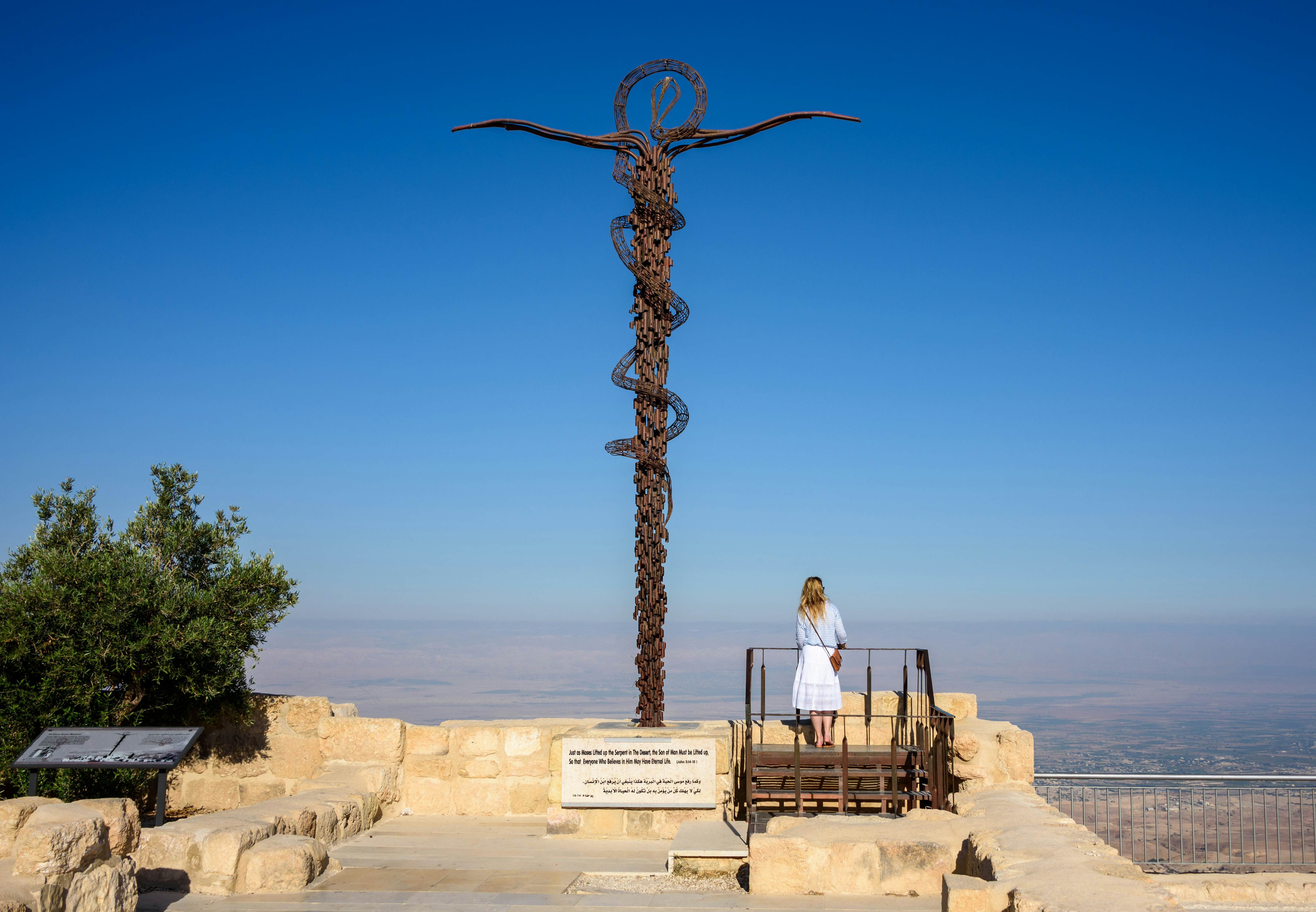 Serpentine Cross at the top of Mount Nebo in Jordan, where Moses viewed the Holy Land.
Serpentine Cross at the top of Mount Nebo in Jordan, where Moses viewed the Holy Land.
At Mt Nebo near Madaba, you can stand in the same spot where Moses looked out over the Holy Land.
3. Jerash
Best place for archaeology fans
Jerash, a convenient day trip from Amman, is home to the ruins of ancient Gerasa, one of the best-preserved Roman cities in the Middle East. You don’t need to be a history buff to appreciate the beauty of this impressive site. However, hiring a guide either on-site or in advance through a tour operator can enhance your experience, as signage is limited.
What are the must-see attractions in Jerash?
The Forum, bound by curving rows of stone columns, is a can’t-miss attraction in Jerash. It is best viewed from above. Make sure to take the steps up to the Temple of Zeus for a panoramic view of the ancient city, with modern-day Jerash in the background.
According to historical records, the Forum served as the central public space for civic and religious activities in ancient Gerasa. The Temple of Artemis, Hadrian’s Arch, and the North and South Theaters are also key attractions that showcase the grandeur of Roman architecture and urban planning.
What seasonal activities can I enjoy in Jerash?
The Jerash region is known for producing superior olives and olive oil. If you’re traveling to Jordan in September or October, consider booking a multi-day trip that includes olive harvesting, lunch, and an overnight stay with a local family, as well as a visit to Ajloun Castle.
Participating in the olive harvest provides a unique cultural experience and supports local communities. The harvest season is a vibrant time to visit, with festivals and celebrations that showcase the region’s agricultural heritage.
What should I consider when planning a visit to Jerash?
The site at Jerash is vast, so plan accordingly. Allocate a minimum of three hours to see the main sights, plus additional time to explore outlying areas and take photos. Wear comfortable shoes and bring sun protection, as the site offers limited shade.
Buses from Amman to Jerash take about an hour, making it an easy day trip. Consider visiting early in the morning or late in the afternoon to avoid the midday heat and crowds.
How has tourism impacted the preservation of Jerash?
Tourism has played a crucial role in the preservation and restoration of Jerash. Revenue from tourism helps fund ongoing archaeological research and conservation efforts, ensuring that this historical site remains accessible for future generations.
Sustainable tourism practices are increasingly emphasized to minimize the environmental impact and support local communities. Educational programs and guided tours also contribute to raising awareness about the importance of preserving Jerash’s cultural heritage.
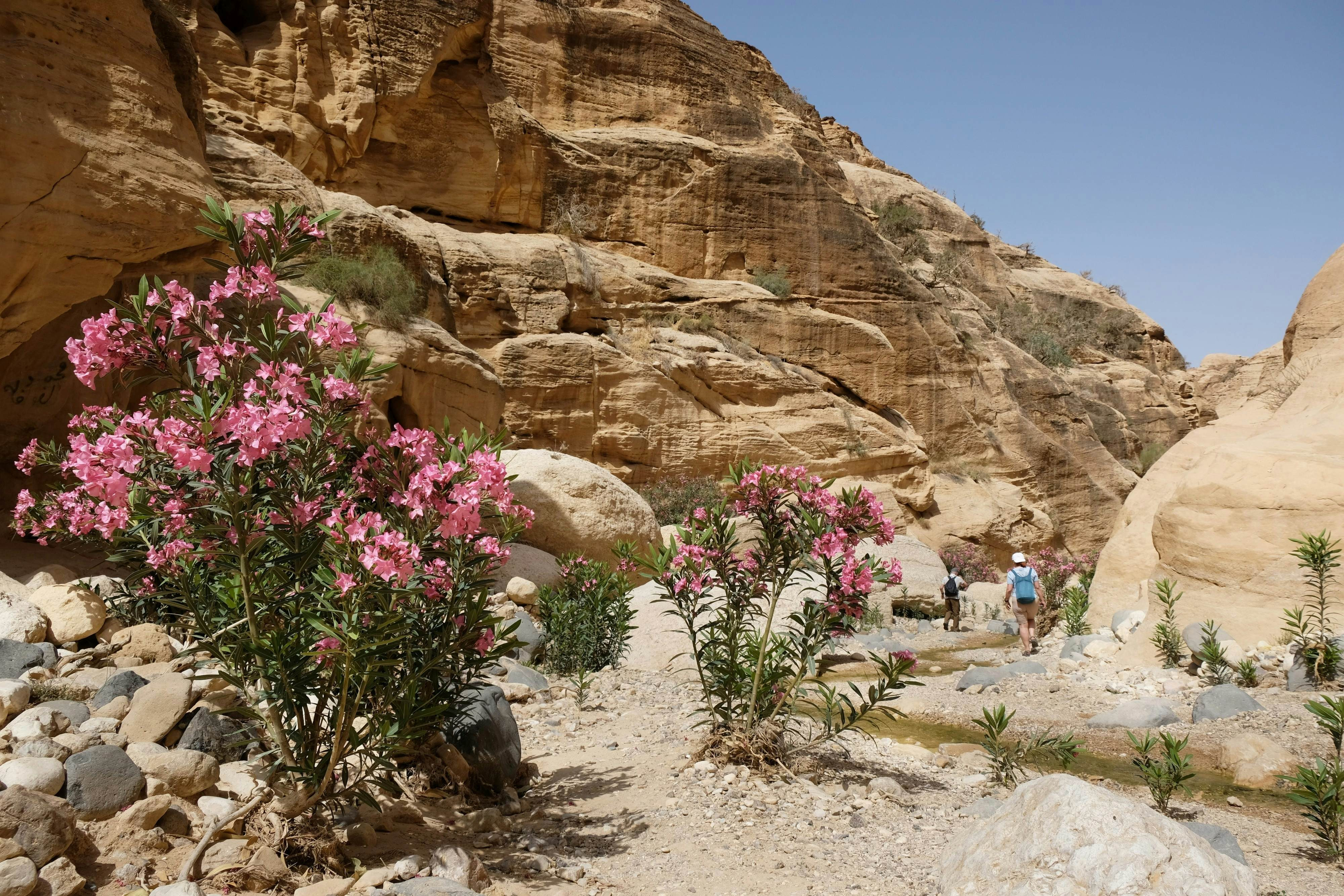 Scenery in Wadi Ghuweir Canyon in Dana Biosphere Reserve in Jordan with blooming oleander bushes.
Scenery in Wadi Ghuweir Canyon in Dana Biosphere Reserve in Jordan with blooming oleander bushes.
Dana Biosphere Reserve in the south preserves mountain ecosystems and seasonal wadis.
4. Dana Biosphere Reserve
Best region for wildlife
Around 194 km (121 miles) south of Amman is Dana Biosphere Reserve, Jordan’s largest protected area, covering a rugged collection of mountains and wadis (seasonal river channels). Here, you’ll find more than 800 plant species, some 215 bird species, rare mammals such as the Syrian wolf and Nubian ibex, and an ancient archaeological site. Hikers are drawn to the area’s unique ecology, varied terrain, incredible views, and serenity.
What makes Dana Biosphere Reserve unique?
Dana Biosphere Reserve stands out due to its exceptional biodiversity and stunning landscapes. Covering approximately 308 square kilometers, the reserve encompasses four distinct bio-geographical zones, resulting in a remarkable variety of flora and fauna. According to UNESCO, Dana is one of the most important reserves in the Middle East.
The reserve is home to several endangered species, making it a critical area for conservation efforts. The varied terrain, from rugged mountains to seasonal river channels, offers diverse hiking and trekking opportunities.
What activities can I enjoy in Dana Biosphere Reserve?
Hikers and nature enthusiasts will find plenty to do in Dana. The reserve offers several well-marked trails that cater to different fitness levels. You can also engage in bird watching, wildlife spotting, and exploring the ancient archaeological sites.
Consider making Feynan Ecolodge your base for connecting with Bedouin culture and the land. The lodge offers locally led experiences such as grazing goats with local shepherds, hiking in the wadis with Bedouin guides, baking arbood bread, learning about medicinal plants, or making Arabic coffee over an open fire.
What are the accommodation options in Dana Biosphere Reserve?
Feynan Ecolodge is a popular choice for eco-conscious travelers. This award-winning lodge offers a unique desert experience with a focus on sustainability and community engagement. The lodge operates on solar power and employs local Bedouins, providing economic opportunities for the community.
Alternatively, you can find guesthouses and campsites in the nearby village of Dana, offering a more rustic experience. Staying in local accommodations supports the community and provides a deeper insight into Bedouin culture.
What should I know about hiking in Dana Biosphere Reserve?
For intrepid travelers looking to sleep under the stars, multi-day hikes in Dana and on the Dana-to-Petra section of the Jordan Trail can easily be arranged through tour operators. The Jordan Trail is a 650-kilometer hiking trail that spans the length of Jordan, offering a unique way to experience the country’s diverse landscapes and cultural heritage.
Before embarking on a hike, check the weather conditions and obtain necessary permits from the Dana Biosphere Reserve Visitor Center. Hiring a local guide is highly recommended, as they can provide valuable insights into the local flora, fauna, and cultural history, as well as ensure your safety.
5. The Dead Sea
Best place for natural healing
The Dead Sea, bordered by Jordan to the east and Israel and Palestine to the west, is renowned for its high salt concentration, which allows visitors to float effortlessly. It is also known for its mineral-rich mud and therapeutic properties. A visit to the Jordanian shores of the Dead Sea offers a unique opportunity to soak and scrub your worries away with a natural spa experience.
What are the health benefits of visiting the Dead Sea?
The Dead Sea’s unique composition of minerals, including magnesium, calcium, and potassium, is believed to have numerous health benefits. The mineral-rich mud is often used in skincare treatments to exfoliate and rejuvenate the skin.
Additionally, the high oxygen content and low allergen levels in the air are thought to be beneficial for people with respiratory conditions. The dry climate is also believed to alleviate symptoms of skin disorders such as psoriasis and eczema.
How can I enjoy a DIY Dead Sea experience?
For a DIY Dead Sea experience, slather on some mineral-rich mud on the shore before wading in to float in the high-salinity water. The mud helps to draw out impurities from the skin, leaving it feeling soft and refreshed.
After applying the mud, let it dry for about 15-20 minutes before rinsing it off in the Dead Sea. The high salt concentration makes it easy to float, allowing you to relax and enjoy the unique sensation of weightlessness.
What luxury spa treatments are available at the Dead Sea?
For a more indulgent experience, consider visiting one of the numerous luxury hotel spas along the shoreline. These spas offer a range of treatments using Dead Sea minerals, including mud wraps, salt scrubs, and massages.
The Kempinski Hotel Ishtar is particularly well-regarded for its spa treatments, which combine traditional techniques with modern therapies. Many spas also offer wellness programs that include yoga, meditation, and healthy eating, providing a holistic approach to health and relaxation.
What outdoor activities can I enjoy near the Dead Sea?
In the warmer months, consider an outdoor jaunt in nearby Wadi Mujib, the “Grand Canyon of Jordan,” with a hike in the shade of the gorge followed by a dip in the cool, fresh water. Wadi Mujib offers a range of hiking trails that vary in difficulty, from easy walks to challenging canyoning adventures.
You can also hike in the wadis near South Ghor at the south end of the Dead Sea with the Al Numeira Environmental Association. These hikes offer opportunities to explore the region’s natural beauty and learn about local conservation efforts.
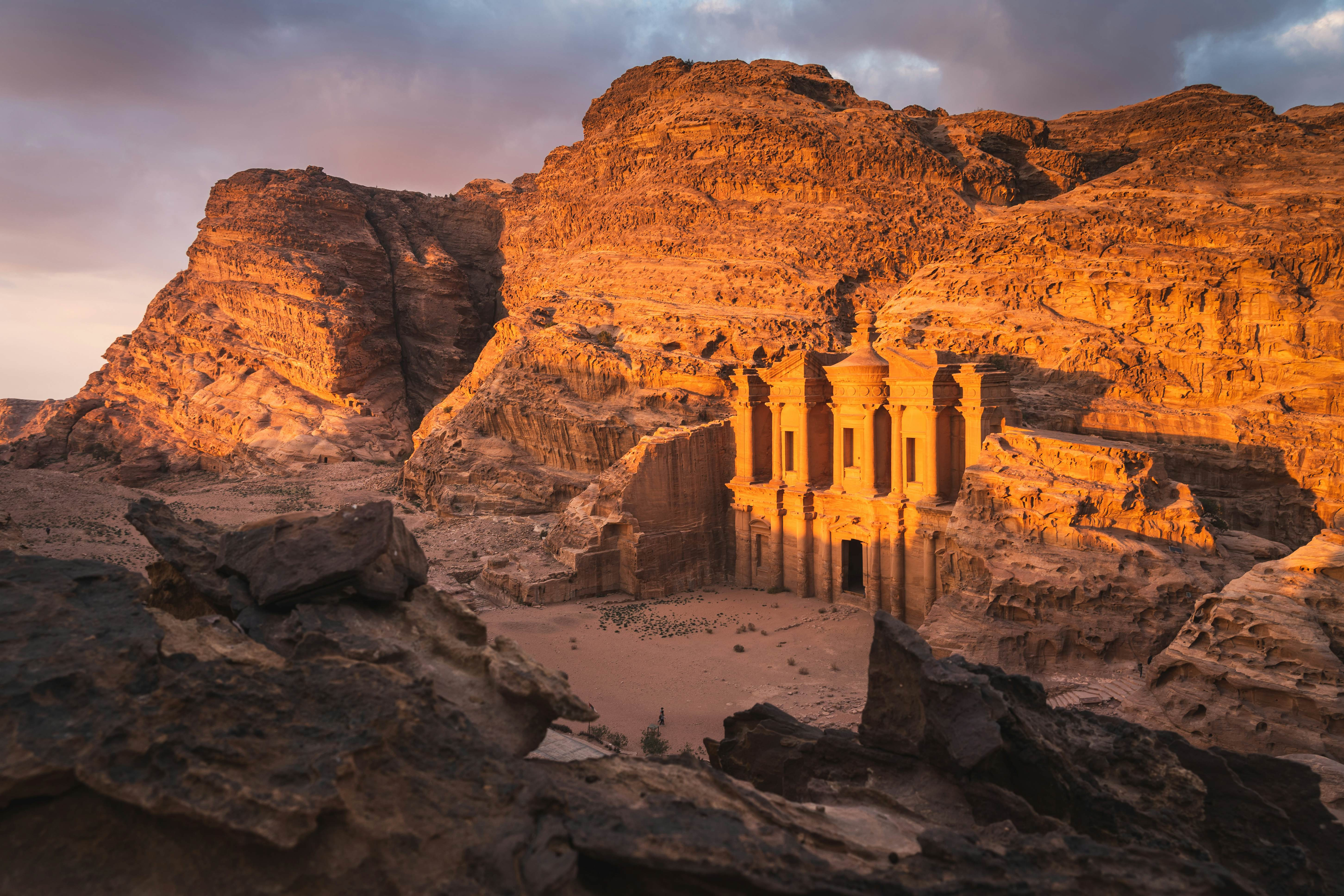 The Monastery or Ad-Dayr at sunset in the ruins of Petra, Jordan.
The Monastery or Ad-Dayr at sunset in the ruins of Petra, Jordan.
Few places in the region can match the majesty of the ruins of Petra.
6. Petra
Best place for magnificent monuments
Petra, a UNESCO World Heritage site, is one of the most iconic destinations in Jordan. Known as the “Rose Red City” because of the pink sandstone it is carved from, the site is home to such landmark monuments as the Treasury and the Monastery.
No matter how long you’re in Jordan, you’ll want to make time to explore Petra. The ruined capital of the Nabataean civilization sprawls across 264 sq km (102 sq miles) of desert, and you could easily spend several days trekking around the ruins and outcrops and marveling at the masonry skills and rich history of its ancient inhabitants.
What are the must-see monuments in Petra?
The Treasury, also known as Al-Khazneh, is perhaps the most iconic structure in Petra. This magnificent facade is carved directly into the sandstone cliff and served as the tomb of the Nabataean King Aretas III.
The Monastery, or Ad Deir, is another impressive monument that rivals the Treasury in grandeur. Reaching the Monastery requires a challenging hike up hundreds of steps, but the breathtaking views from the top are well worth the effort.
The Siq, a narrow sandstone canyon that serves as the main entrance to Petra, is also a must-see. Walking through the Siq is an experience in itself, as the towering cliffs on either side create a sense of anticipation and wonder.
How much time should I allocate for visiting Petra?
You can choose your own level of adventure depending on your interests, time, and ability. If you’re short on time, take the road most traveled and hike through the narrow sandstone canyon known as the Siq to reach the carved stone facade of the Treasury, which you might recognize from the movie Indiana Jones and the Last Crusade.
However, to fully appreciate the site, it is recommended to spend at least two to three days exploring Petra. This allows you to visit the main monuments at a leisurely pace and venture off the beaten path to discover hidden gems.
What are the options for guided tours in Petra?
If you have multiple days and want to go beyond the most common sites, book a guided tour that includes storytelling, hiking, Arabic coffee, and meals prepared by expert local guides. Local guides can provide valuable insights into the history, culture, and geology of Petra, enhancing your overall experience.
You can also hire a guide at the entrance to Petra, but it is advisable to book in advance through a reputable tour operator to ensure you get a knowledgeable and experienced guide.
What alternative hiking routes can I take in Petra?
Want to see Petra from another angle? Take a tip from Jordanian mountaineer Mohammed Ziad Abdullatif and hike to Petra from Little Petra, or via the Jordan Trail. “The Petra Back Trail from Little Petra to Petra is my all-time favorite hike for its location, scenery, history, and that first glimpse of the Monastery when it starts to appear,” Abdullatif says.
Hiking from Little Petra offers a unique perspective on the landscape and allows you to approach Petra from a less crowded entrance. The Jordan Trail also provides a challenging and rewarding hiking experience, with stunning views of the surrounding mountains and desert.
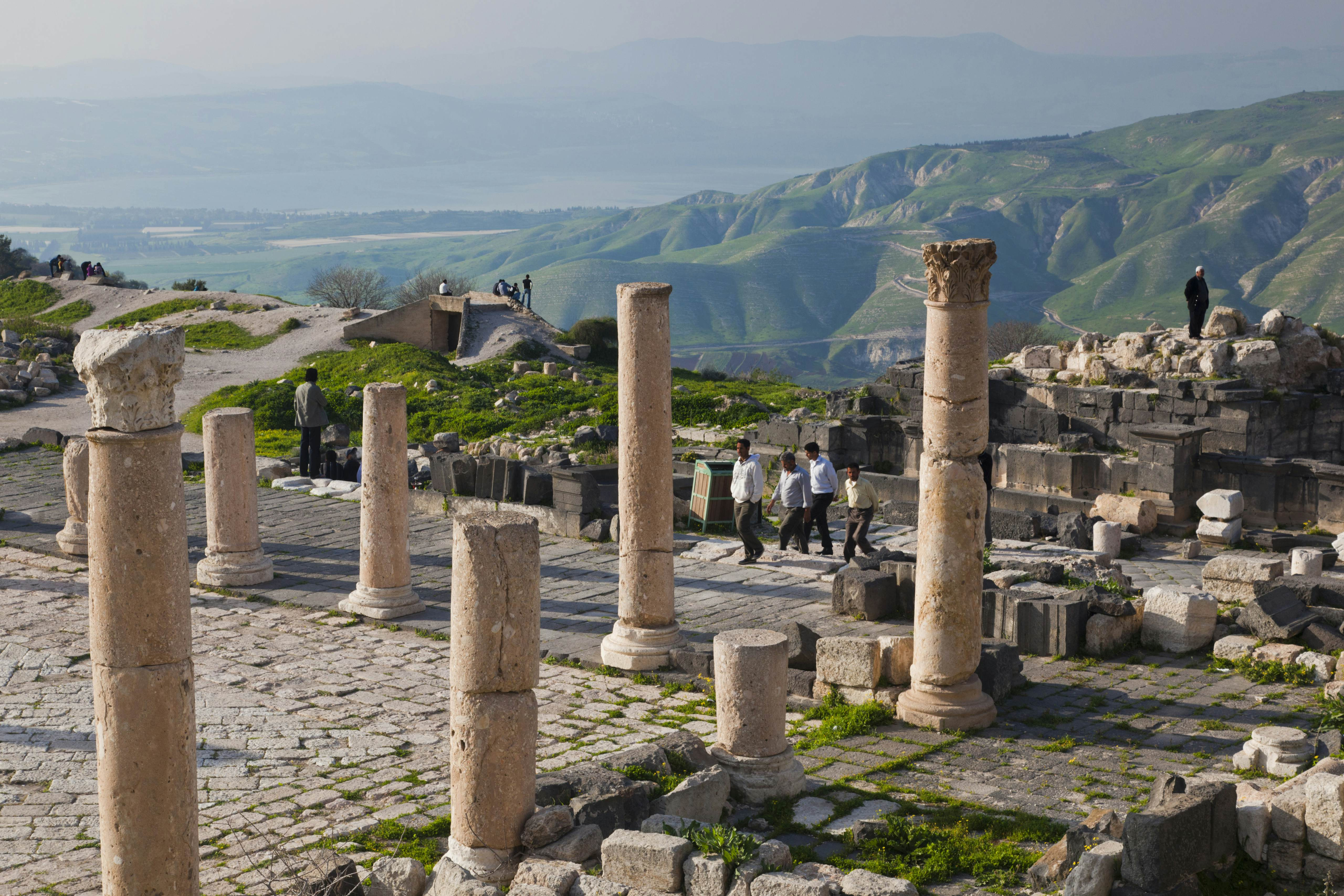 People walking around the ruins of the ancient Jewish and Roman city of Gadara at Umm Qais, Jordan.
People walking around the ruins of the ancient Jewish and Roman city of Gadara at Umm Qais, Jordan.
The ancient ruins of Gadara are just one of the sights waiting at Umm Qais.
7. Umm Qais
Best place for connecting with local culture
Located about 117 km (73 miles) north of Amman, Umm Qais is an ideal base for exploring northern Jordan with its forested trails, authentic farm-to-fork meals, warm hospitality, and less-visited archaeological sites. While you hike, you can enjoy sweeping views over the surrounding countryside and rewarding encounters with local people.
What historical sites can I visit in Umm Qais?
Umm Qais is home to the ancient Greco-Roman city of Gadara, which offers a fascinating glimpse into the region’s rich history. Explore the ruins of the city, including the theater, basilica, and colonnaded street.
According to historical accounts, Gadara was a prominent cultural and intellectual center during the Roman period, attracting scholars, poets, and philosophers. The city’s strategic location, overlooking the Sea of Galilee and the Golan Heights, also made it an important military stronghold.
What local experiences are available in Umm Qais?
Consider seeking out local experiences arranged through an experienced operator. Explore the 2300-year-old Greco-Roman ruins of Gadara with a local guide, or go foraging for wild foods with a local farmer or harvesting honey with a village beekeeper.
Engaging with local communities provides a unique opportunity to learn about Jordanian culture and traditions. You can also participate in cooking classes, traditional craft workshops, and cultural exchange programs.
What hiking opportunities does Umm Qais offer?
Hiking enthusiasts are spoiled for choice at Umm Qais, with numerous trails weaving through Yarmouk Forest Reserve – a favorite hiking spot for savvy locals and in-the-know visitors. Hire a local guide through the Royal Society for the Conservation of Nature or a tour operator.
An expert guide can introduce you to the local flora and fauna and (if you’re lucky) prepare shai (tea) to share in the shade of the deciduous oak trees that grow here. The Yarmouk Forest Reserve is home to a variety of plant and animal species, including oak trees, wild orchids, and migratory birds.
What should I know about the Jordan Trail in Umm Qais?
Umm Qais is also the starting point for the Jordan Trail, which runs for 675 km (420 miles) to Aqaba in the south. Book a guided day hike to the Wadi Arab Dam through an operator for a taste of the scenery.
Trek the northern section of the Jordan Trail in springtime to see the region carpeted in wildflowers. The Jordan Trail offers a challenging and rewarding hiking experience, with stunning views of the surrounding landscape and opportunities to connect with local communities along the way.
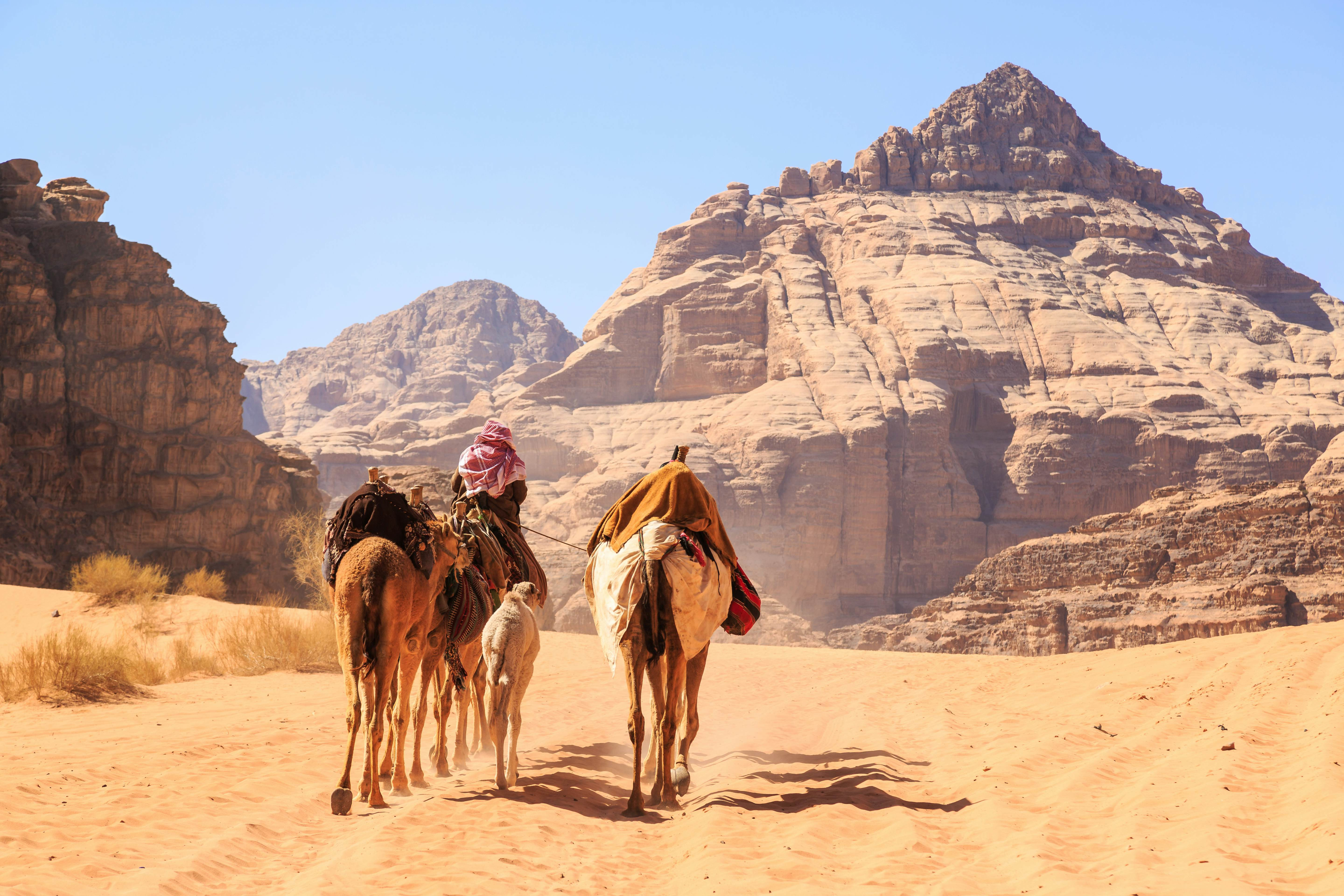 Caravan of camels walking in the Wadi Rum desert in Jordan on a sunny day.
Caravan of camels walking in the Wadi Rum desert in Jordan on a sunny day.
The desert landscapes of Wadi Rum will stay with you for a lifetime.
8. Wadi Rum
Best place for stunning desert landscapes
Wadi Rum, also known as the Valley of the Moon, is a protected desert wilderness in southern Jordan. It features dramatic sandstone mountains, towering rock arches, and vast sandy plains.
While the landscapes look like something from the movie Dune, No spaceship is required to visit Wadi Rum. Instead, you can explore this marvelous expanse of sandy desert and rocky outcrops on foot, by camel, by 4WD, or even by hot-air balloon. Eroded mountains and soaring rock arches rising over a sea of rust-colored sand make this protected area one of the most photogenic and beautiful places in the world.
What activities can I enjoy in Wadi Rum?
Many travelers come to Wadi Rum seeking silence and a slower pace of life, but the site has become so popular that you may have to head away from the main sites and desert camps to find true tranquility. For an intimate introduction to the landscape, spend a day with a Bedouin guide hiking, cooking, and learning how to put up a traditional Bedouin tent.
Jeep tours are a popular way to explore the vast desert landscape and visit key attractions such as Lawrence’s Spring, the Little Bridge, and the Khazali Canyon. Camel trekking offers a more traditional and immersive experience, allowing you to travel at a slower pace and connect with the desert environment.
What should I know about rock climbing in Wadi Rum?
As one of the best places in the world for rock climbing, Wadi Rum also attracts plenty of active adventurers. Book an overnight climbing and camping trip with Bedouin Campsite and Tours and learn from guides who have spent their lives scaling these sandstone giants.
Wadi Rum offers a variety of climbing routes that cater to different skill levels, from beginner-friendly climbs to challenging multi-pitch ascents. Climbing with a local guide is highly recommended, as they can provide valuable insights into the best routes and ensure your safety.
What accommodation options are available in Wadi Rum?
Wadi Rum offers a range of accommodation options, from traditional Bedouin camps to luxury desert resorts. Bedouin camps provide a unique cultural experience, allowing you to sleep in traditional tents and enjoy Bedouin cuisine and hospitality.
Luxury desert resorts offer more modern amenities, such as air-conditioned rooms, swimming pools, and spa treatments. These resorts provide a comfortable and relaxing base for exploring the desert landscape.
How can I combine a visit to Wadi Rum with other destinations in Jordan?
The Red Sea resort city of Aqaba is an hour’s drive away and the perfect place for an indulgent spa treatment and a luxury beach stay after working up a sweat in Wadi Rum. Aqaba offers a range of water sports activities, such as snorkeling, diving, and windsurfing.
You can also visit the ancient city of Petra, which is located about two hours north of Wadi Rum. Combining a visit to Wadi Rum with Petra and Aqaba allows you to experience the diverse landscapes and cultural attractions of southern Jordan.
FAQ about Jordan Tourism Sites
1. What is the best time to visit Jordan for tourism?
The best time to visit Jordan is during the spring (March to May) and autumn (September to November). The weather is mild, making it ideal for outdoor activities and sightseeing.
2. Do I need a visa to visit Jordan?
Many nationalities can obtain a visa on arrival at Queen Alia International Airport in Amman or through designated border crossings. It’s recommended to check the specific visa requirements based on your nationality before traveling.
3. What currency is used in Jordan?
The Jordanian Dinar (JOD) is the official currency. Credit cards are widely accepted in major cities and tourist areas, but it’s useful to carry some cash for smaller establishments and remote areas.
4. Is it safe to travel in Jordan?
Jordan is generally considered a safe country for tourists. However, it’s always wise to stay informed about local conditions and follow standard safety precautions, such as keeping valuables secure and avoiding travel to border areas.
5. What languages are spoken in Jordan?
Arabic is the official language. English is widely spoken in tourist areas, hotels, and restaurants.
6. What should I wear when visiting Jordan?
Modest dress is recommended, especially when visiting religious sites. Lightweight, breathable clothing is suitable for the warm climate, and comfortable shoes are essential for exploring historical sites.
7. How can I get around Jordan?
Rental cars are a popular option for independent travel, but public transportation, including buses and taxis, is also available. Ridesharing services like Uber and Careem operate in major cities.
8. What are some cultural customs I should be aware of in Jordan?
Hospitality is highly valued in Jordanian culture. Accepting offers of tea or coffee is a sign of respect. It’s also polite to dress modestly and be mindful of local customs, particularly during religious holidays.
9. What are some popular Jordanian dishes I should try?
Mansaf (lamb cooked in fermented dried yogurt and served with rice), falafel, hummus, and kunafeh (a sweet cheese pastry) are some of the must-try dishes in Jordan.
10. How can SIXT.VN enhance my trip to Jordan?
SIXT.VN offers convenient and reliable services such as airport transfers, hotel bookings, and guided tours to help you explore Jordan’s top tourism sites with ease. With SIXT.VN, you can customize your itinerary and enjoy a hassle-free travel experience.
Let SIXT.VN Help You Plan Your Jordanian Adventure
Are you ready to explore the wonders of Jordan? From the ancient city of Petra to the stunning landscapes of Wadi Rum, Jordan offers a wealth of unforgettable experiences.
Let SIXT.VN take the stress out of planning your trip. We offer a range of services tailored to your needs, including:
- Airport Transfers: Start your journey with a seamless and comfortable transfer from Queen Alia International Airport to your hotel.
- Hotel Bookings: Choose from a wide selection of hotels to suit your budget and preferences, ensuring a comfortable and convenient stay.
- Guided Tours: Discover Jordan’s top attractions with our expert guides, who will provide valuable insights and ensure a memorable experience.
Contact us today to learn more about our services and start planning your dream trip to Jordan. Visit our website at SIXT.VN or call us at +84 986 244 358. Let SIXT.VN be your trusted partner in exploring the best of Jordan tourism sites. Address: 260 Cau Giay, Hanoi, Vietnam. Hotline/Whatsapp: +84 986 244 358. Website: SIXT.VN.



